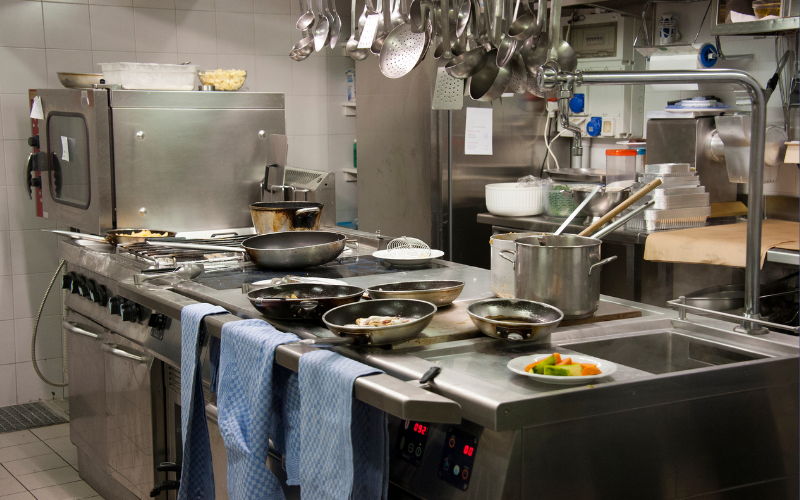Foodborne Illness, Infection, Intoxication… Are They the Same?

While it’s true that foodborne illness, infection, and intoxication are terms related to diseases caused by microorganisms or toxic substances, each refers to a completely different process.
It’s important not to confuse or mix them up.
In any case, what is certainly true is that foodborne illnesses (FBIs) are a global problem that can affect many unsuspecting people.
And that’s why today, we’d like to clarify these concepts.
Nerea Cristófalo, Food Safety Consultant at Andy, clarifies the differences between each of them in this post.
What is a Foodborne Illness?
A foodborne illness is a disease caused by the ingestion of food or water contaminated with microorganisms that produce toxins in the small intestine.
These microorganisms can be bacteria, viruses, or parasites.
The toxin produced by the microorganism is absorbed by the body and causes gastrointestinal symptoms such as diarrhoea, nausea, vomiting, and fever.
In general, we talk about “foodborne illnesses” because it’s often not clear if the causative agent is a toxin or a live microorganism, but until the origin of the FBI is known, we should talk about Foodborne Illness.
Some examples of foodborne illnesses include:
- Salmonella: it’s a bacterium that can cause foodborne illnesses through the consumption of foods contaminated with infected animal faeces, such as raw or undercooked meats, eggs, and dairy products.
- E.coli: this bacterium is a common cause of foodborne illnesses worldwide. It can be found in raw or undercooked foods, especially in beef, but also in other foods such as unpasteurised milk and raw vegetables.
- Norovirus: a highly contagious virus that can spread through contaminated food and water, as well as from person to person. Symptoms include vomiting, diarrhoea, and stomach pain.
- Listeria: this bacterium can cause severe foodborne illnesses, especially in people with weakened immune systems, pregnant women, and the elderly. It’s commonly found in refrigerated foods such as cold cuts and unpasteurised soft cheeses.
- Campylobacter: a bacterium commonly found in raw or undercooked poultry, as well as contaminated water.
- Staphylococcus aureus: a bacterium that produces a toxin that can cause food poisoning, often associated with improperly handled foods such as meats and dairy products.
- Clostridium perfringens: a bacterium found in soil, animal, and human feces, which can contaminate undercooked meat, poultry, and fish.
- Vibrio: a genus of bacteria found in saltwater that can cause infections in people who consume raw or undercooked seafood.
- Bacillus cereus: a bacterium commonly found in soil that can contaminate food during harvesting, storage, or preparation. It can cause infections or food poisoning.
- Cryptosporidium: a parasite found in contaminated water that can cause gastrointestinal infections.
- Toxoplasma gondii: a parasite found in raw or undercooked meat that can cause infections in people with weakened immune systems or pregnant women.
What is an infection?
An infection is a disease caused by the invasion and multiplication of microorganisms in the body.
Foodborne infection occurs when contaminated food or water containing live microorganisms, such as bacteria, viruses, or parasites, is ingested. These microorganisms can multiply in the food or the human body and cause a range of symptoms that can vary in severity.
Some examples of microorganisms that can cause foodborne infections are Salmonella, rotavirus, or Anisakis.
What is an intoxication?
Intoxication is a disease caused by the ingestion of toxic substances such as chemicals, poisons, drugs, or alcohol.
Toxic substances can be absorbed by the body through the gastrointestinal tract or inhaled through the lungs.
These substances can come from cleaning products, pesticides, veterinary medicines, or environmental contaminations. Some examples of toxins that can cause food poisoning are botulinum toxin or aflatoxin.
The symptoms of intoxication can vary depending on the toxic substance and the amount ingested but may include dizziness, nausea, vomiting, seizures, and even death.
In other words, the main difference between foodborne illness, infection, and intoxication is the underlying cause of the disease.
Foodborne illness is caused by microorganisms that produce toxins in the intestine, infection is caused by the invasion and multiplication of microorganisms in the body, and intoxication is caused by the ingestion of toxic substances.
The difference between foodborne infection and intoxication lies in the agent that causes the disease.
In foodborne infections, the agent is a live microorganism that multiplies in the food or our body and can cause a set of different symptoms. In foodborne intoxication, the agent is a toxic substance that produces damage in our organism.
It’s important to know the difference between both types of diseases to prevent and treat them properly.
How do we prevent foodborne illnesses, intoxications, and infections in a foodservice business?
Among other important hygiene processes, by preventing cross-contamination or the transfer of microorganisms (bacteria, viruses, or other pathogens) from a contaminated food to one that isn’t, which can lead to foodborne illnesses.

How do we prevent cross-contamination?
Following good food handling practices as those outlined below:
- Food separation: Store raw, cooked, and ready-to-serve foods in separate areas of the restaurant to avoid cross-contamination. Make sure to use separate cutting boards and utensils for each type of food.
- Proper food handling: Train your staff in safe food handling techniques, such as frequent handwashing, glove use, and glove change between tasks. Avoid touching cooked or ready-to-serve foods with bare hands.
- Appropriate temperatures: Storing and cooking foods at the right temperatures is crucial to prevent contamination. Keep cold foods below 4°C and hot foods above 60°C. Regularly check the temperature of foods and refrigerators and freezers.
- Food labelling and rotation: Label and date foods to ensure that the oldest foods are used first. Properly rotating foods can help reduce the risk of cross-contamination.
- Cleaning and hygiene: It’s important to maintain good hygiene in all areas of the restaurant. Wash and disinfect surfaces, utensils, and equipment that come into contact with food regularly and between each use.
- Continuous monitoring: Regularly supervise your staff to ensure they are following proper food safety and handling standards.
By following these practices, you’ll prevent cross-contamination in your restaurant and provide a safe and healthy experience for your customers, avoiding the dreaded consequences of foodborne illnesses as referred to in this post.
What’s the best way to have all your hygiene protocols under control?
ANDY!
The leading digital assistant in the foodservice industry will help your teams comply with cleaning, hygiene, and disinfection protocols, guiding them through their task list, training, communications, etc…

